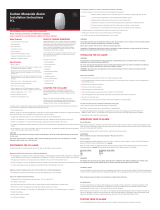
11
Installation Instructions
Where Not to Install Your CO Alarm
To avoid causing damage to the unit, to provide optimum
protection, and to prevent unnecessary alarms, follow
the instructions below where NOT to install this alarm:
It is recommended that you do not install this CO alarm in garages, kitchens or
furnace rooms. Installation in these areas could lead to nuisance alarms, may
expose the sensor to substances that could damage or contaminate it, or the
alarm may not be heard by persons in other areas of the home, especially if they
are sleeping.
In the garage, vehicle exhaust can contain some carbon monoxide. These levels
are higher when the engine is first started. Within hours of starting a vehicle and
backing it out of the garage, the levels present over time can activate the alarm
and become a nuisance.
In the kitchen and furnace room, some gas appliances can emit a short burst of
carbon monoxide upon start-up. This is normal. If your CO alarm is mounted too
close to these appliances, it may alarm often and become a nuisance.
If you must install a Kidde CO alarm near a cooking or heating appliance,
install
AT LEAST
5 FEET away from the appliance.
Do not install in excessively dusty, dirty or greasy areas such as kitchens, garages
and furnace rooms. Dust, grease or household chemicals can contaminate or coat
the alarm’s sensor, causing the alarm not to operate properly.
Do not obstruct the vents located at the top and bottom of the alarm. Place the
alarm where drapes, furniture or other objects do not block the flow of air to the
vents.
Do not install in dead air space, such as peaks of vaulted ceilings or gabled roofs,
where carbon monoxide may not reach the sensor in time to provide early warn-
ing.
Do not install in turbulent air from ceiling fans. Do not install near doors and win-
dows that open to the outside, near fresh air vents, or anywhere that is drafty.
Rapid air circulation from fans or fresh air from outside may cause the sensor to
display an inaccurate reading in the presence of CO.
Do not install this alarm in a switch- or dimmer-controlled outlet.
Do not install in areas where the temperature is colder than 40˚F (4.4˚C) or hotter
than 100˚F (37.8˚C). These areas include unconditioned crawl spaces, attics, porch-
es and garages. Extreme temperatures will affect the sensitivity of the alarm.
Do not install CO alarm near deep cell large batteries. Large batteries have emis-
sions that can cause the alarm to perform at less than optimum performance.






















